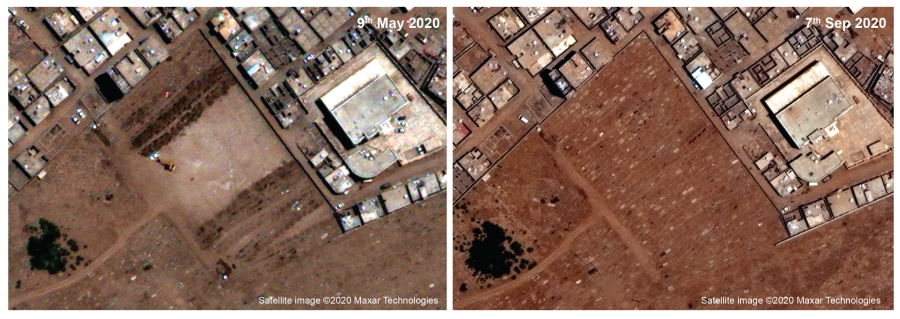Satellite images suggest deaths more than doubled in Aden, Yemen during intense COVID-19 transmission
28 October 2020 London School of Hygiene & Tropical Medicine London School of Hygiene & Tropical Medicine https://lshtm.ac.uk/themes/custom/lshtm/images/lshtm-logo-black.png
***The news story in Arabic***
The true death toll of the COVID-19 pandemic in Yemen remains unknown but according to new research highlighted in a pre-print study, there is a consensus that the pandemic has had a considerable impact on the health system.
The research, which is not yet peer-reviewed, was led by the London School of Hygiene & Tropical Medicine in partnership with the technology and innovation company the Satellite Applications Catapult, which has expertise in geospatial analysis. Using very high-resolution satellite imagery the team quantified burial activity across all identifiable cemeteries within Aden governorate, Yemen, to generate estimates on excess deaths in the region.
Between April and September, a period temporally coinciding with COVID-19 transmission in Aden governorate, they estimated about 2,100 excess deaths, against an expected baseline of about 1,300 deaths. This total is best interpreted as the net sum of deaths due to COVID-19 infection and deaths indirectly attributable to the pandemic (e.g. because of disruptions to health services) or control measures (e.g. problems accessing food).
To the researchers’ knowledge this is the first instance of satellite imagery being used for population mortality estimation.
Professor Francesco Checchi, principal investigator of the study from the London School of Hygiene & Tropical Medicine, said: “Having an accurate picture of the impact of COVID-19 is vital for effective government and humanitarian responses. Unfortunately, in low-income and crisis settings this can be very challenging as it is often difficult to access ground locations. By estimating excess mortality, we aimed to develop a more accurate estimate of the toll of COVID-19 in Yemen.”
The COVID-19 pandemic’s impact on Yemen was expected to be severe, despite its comparatively young population. The country’s five-year protracted crisis has resulted in disrupted health services, overcrowding due to internal displacement, food insecurity and shrinking humanitarian aid.
Yemen recorded its first laboratory-confirmed coronavirus disease on 10 April 2020. The epidemic was expected to peak earliest and more dramatically in Aden governorate due to overcrowding and limited mitigation measures.
In May 2020, videos posted on social media and information from key informants reported high numbers of fresh graves, suggesting a spike in burial activity. The use of mechanical excavators in place of human gravediggers suggested that demand exceeded routine capacity, while, during the same period, Médecins sans Frontières reported a peak in hospital admissions, with a very high case-fatality ratio. Media also reported that a shortage of personal protective equipment forced several hospitals to close or reject patients exhibiting COVID-19 like symptoms.
However, as of 25 October 2020, Yemen had reported 2,064 confirmed SARS-CoV-2 infections with 600 deaths, but the reliability of these official numbers is undermined by low testing capability.
Emilie Koum Besson, lead author from the London School of Hygiene & Tropical Medicine, said: “Given limited testing capacity and locally different approaches to defining and recording direct COVID-19 deaths, excess mortality may be the only measure that allows to draw comparison across different geographical settings. Though our method cannot distinguish direct from indirect virus deaths, estimating excess mortality attributable to the COVID-19 pandemic in humanitarian setting captures the whole system impact of the pandemic. It can inform our understanding of how different factors, national strategies and policies have affected the spread and severity of the pandemic.”
For example, study findings indicate that the peak death rate in Aden (about 650% according to Civil Registry data, or about 250% based on satellite imagery compared to baseline) was similar to those recorded in London and New York (respectively 200% and 600% the baseline) despite significantly different containment measures.
Professor Checchi said: “We believe this is the first-time satellite imaging has been used to help model the impact of infectious disease outbreaks. This new technique is very exciting for global health. Remote analysis could pave the way for the development of accurate health data in areas where this is currently not possible, providing organisations and policymakers with new evidence to make potentially life-saving decisions.”
Andy Norris, co-author from the Satellite Applications Catapult, said: “‘The applications of satellite data to provide information on humanitarian crises are vast. Together with LSHTM, for the first time, we have combined satellite imagery with cutting-edge modelling techniques to provide information that was simply not otherwise available, and which can inform the response from the international community. It is a piece of transformational work for the satellite industry and the people of Yemen.”
The authors acknowledge limitations of their work, including that the temporal association of SARS-CoV-2 transmission and excess mortality is not conclusive evidence that the pandemic caused the observed increase in burials. The analysis would not have been able to capture a family’s preference to bury their members in their origin locality (villages) in other governorates and difference in local burial practices such as cremation.
The team are now replicating the study in Mogadishu, Somalia. Both studies are funded by UK aid from the UK Government, however the findings and views expressed on them, do not necessarily reflect that of official UK Government policy.
Publication
Emilie Koum Besson, Andy Norris, Abdulla S. Bin Ghouth, Terri Freemantle , Mervat Alhaffar , Yolanda Vazquez, Chris Reeve2, Patrick J. Curran4, Francesco Checchi, Excess mortality during the COVID-19 pandemic in Aden governorate, Yemen: a geospatial and statistical analysis.
LSHTM's short courses provide opportunities to study specialised topics across a broad range of public and global health fields. From AMR to vaccines, travel medicine to clinical trials, and modelling to malaria, refresh your skills and join one of our short courses today.